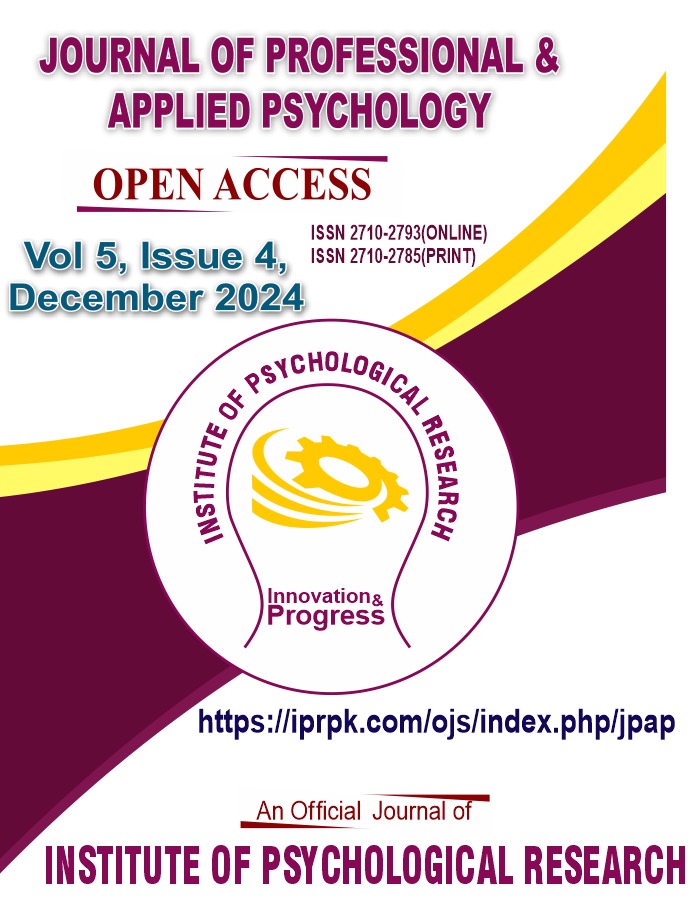Body Esteem as Mediator between Social Media Addiction and Eating Behaviors among Young Adults
DOI:
https://doi.org/10.52053/jpap.v5i4.338Keywords:
Body Esteem, Eating Behaviors, Social Media Addiction, Young AdultsAbstract
Excessive use of social media and overindulgence of young adults on it has led to high risk eating behaviors. Viewing idealized body images of extremely thin and toned figures on social media increases body dissatisfaction, leading to eating disturbances. Body esteem is individual’s perception and thoughts about his body, weight and appearance. That perception can either be positive or negative. Although, now a days, the number of young adults using social media is growing day by day, but little emphasis was given to issues of eating behaviors occurring in them. Therefore, the main aim of this study was to examine the impact of social media addiction on eating behaviors among young adults. In addition, mediating role of body esteem was also studied. A cross-sectional survey design was employed. A sample of 400 university students was collected through purposive sampling technique. Hierarchical regression analysis demonstrated that social media addiction was the most significant and strongest positive predictor of worse eating behaviors whereas body esteem (i.e., appearance, weight and attribution) was negative predictor of worse eating behaviors. Body esteem significantly mediated the relationship between social media addiction and worse eating behaviors. Understanding the role of social media addiction on eating behaviors would help researchers in creating awareness regarding the role of social media addiction and its impact on individual eating behaviors.
References
Alharballeh, S., & Dodeen, H. (2023). Prevalence of body image dissatisfaction among youth in the United Arab Emirates: gender, age, and body mass index differences. Current Psychology, 42, 1317–1326 (2023). https://doi.org/10.1007/s12144-021-01551-8
Al Sabbah, H., Vereecken, C. A., Elgar, F. J., Nansen, T., Aasvee, K., & Abdeen, Z. (2009). Body weight dissatisfaction and communication with parents among adolescents in 24 countries: International cross-sectional survey. Public Health, 9, 52. https://doi.org/ 10.1186/1471-2458-9-52
Alvarenga, M. dos, Scagliusi, F. B., & Philippi, S. T. (2010). Development and validity of the disordered eating attitude scale (deas). Perceptual and Motor Skills, 110(2), 379–395. https://doi.org/10.2466/pms.110.2.379-395
Aparicio-Martinez, Perea-Moreno, Martinez-Jimenez, Redel-Macías, Pagliari, & Vaquero-Abellan. (2019). Social media, thin-ideal, body dissatisfaction and disordered eating attitudes: An exploratory analysis. International Journal of Environmental Research and Public Health, 16(21), 4177. https://doi.org/10.3390/ijerph16214177
Aslam, M., Khan, J. G., Khan, G., Asif, H., Atta, N., Rafique, A., Tahir, T., Ahmed, N., & Ayesha. (2021). Impact of social media and peer pressure on eating behaviors of adolescents. Pakistan BioMedical Journal, 4(2), 181-186. https://doi.org/10.54393/pbmj.v4i2.147
Becker, G. S., & Murphy, K. M. (1988). A theory of rational addiction. Journal of Political Economy, 96(4), 675–700. https://doi.org/10.1086/261558
Blumler, J. G., Katz, E. (1974). The uses of mass communications: Current perspectives on gratifications research. Beverly Hills, CA: Sage Publications.
Cataldo, I., De Luca, I., Giorgetti, V., Cicconcelli, D., Bersani, F. S., Imperatori, C., Abdi, S., Negri, A., Esposito, G., & Corazza, O. (2021). Fitspiration on social media: Body-image and other psychopathological risks among young adults. A narrative review. Emerging Trends in Drugs, Addictions, and Health, 1, 100010. https://doi.org/10.1016/j.etdah.2021.100010
Festinger, L. (1954). A theory of social comparison processes. Human Relations, 7, 117- 140. https://doi.org/10.1177/001872675400700202
Frederick, D. A., Jafary, A. M., Gruys, K., & Daniels, E. A. (2012). Surveys and the epidemiology of body image dissatisfaction. Encyclopedia of Body Image and Human Appearance, 766–774. https://doi.org/10.1016/b978-0-12-384925-0.00121-8
Gilbert, P. (2001). Evolution and social anxiety. Psychiatric Clinics of North America, 24(4), 723–751. https://doi.org/10.1016/s0193-953x(05)70260-4
Harris, E. (2020). Predicting disordered eating behaviors with internet addiction, social media use, and FOMO. Ircommons.uwf.edu. Retrieved March 28, 2023, from https://ircommons.uwf.edu/esploro/outputs/graduate/Predicting-disordered-eating-behaviors-with internet/99380090837206600?institution=01FALSC_UWF
Heinberg, L.J. & Thompson, J.K. (1992) Social comparison: Gender, target importance ratings, and relation to body image disturbance. Journal of Social Behavior and Personality, 7(2), 335-344.
Hilliard, J., Parisi, T., & Bhatt, D. A. (2023, February 21). Social Media Addiction. Addiction Center. https://www.addictioncenter.com/drugs/social-media-addiction/
Hummel, A. C., & Smith, A. R. (2014). Ask and you shall receive: Desire and receipt of feedback via Facebook predicts disordered eating concerns. International Journal of Eating Disorders, 48(4), 436–442. https://doi.org/10.1002/eat.22336
Irving, L. M. (1990). Mirror images: Effects of the standard of beauty on the self- and body-esteem of women exhibiting varying levels of bulimic symptoms. Journal of Social and Clinical Psychology, 9(2), 230–242. https://doi.org/10.1521/jscp.1990.9.2.230
Ka?ucka, S., Kaleta, D., & Makowiec-Dabrowska, T. (2019). Prevalence of dietary behavior and determinants of quality of diet among beneficiaries of government welfare assistance in Poland. International Journal of Environmental Research and Public Health, 16(3), 501. https://doi.org/10.3390/ijerph16030501
LaCaille, L., Patino-Fernandez, A. M., Monaco, J., Ding, D., Upchurch Sweeney, C. R., Butler, C. D., Soskolne, C. L., Gidron, Y., Gidron, Y., Turner, J. R., Turner, J. R., Butler, J., Burns, M. N., Mohr, D. C., Molton, I., Carroll, D., Critchley, H., Nagai, Y., Baumann, L. C., … Söderback, I. (2013). Eating behavior. Encyclopedia of Behavioral Medicine, 641–642. https://doi.org/10.1007/978-1-4419-1005-9_1613
Lewallen, J., & Behm-Morawitz, E. (2016). Pinterest or thinterest? Social comparison and body image on social media. Social Media + Society, 2(1), 205630511664055. https://doi.org/10.1177/2056305116640559
Maraldo, T. M., Zhou, W., Dowling, J., & Vander Wal, J. S. (2016). Replication and extension of the dual pathway model of disordered eating: The role of fear of negative evaluation, suggestibility, rumination, and self-compassion. Eating Behaviors, 23, 187–194. https://doi.org/10.1016/j.eatbeh.2016.10.008
Mendelson, B. K., Mendelson, M. J., & White, D. R. (2001). Body-esteem scale for
adolescents and adults. Journal of Personality Assessment, 76(1), 90–106.
https://doi.org/10.1207/s15327752jpa7601_6
Munir, M., & Dawood, S. (2020). Weight stigma and disordered eating behaviors in Pakistani overweight adolescents: The mediating role of body esteem. Eating and Weight Disorders - Studies on Anorexia, Bulimia and Obesity, 26(6), 1939–1948. https://doi.org/10.1007/s40519-020-01038-8
Padín, P. F., González-Rodríguez, R., Verde-Diego, C., & Vázquez-Pérez, R. (2021). Social Media and eating disorder psychopathology: A systematic review. Cyberpsychology: Journal of Psychosocial Research on Cyberspace, 15(3). https://doi.org/10.5817/cp2021-3-6
Rodgers, R. F., & Melioli, T. (2015). The relationship between body image concerns, eating disorders and internet use, part I: A review of empirical support. Adolescent Research Review, 1(2), 95–119. https://doi.org/10.1007/s40894-015-0016-6
Rolls, B. J., Fedoroff, I. C., & Guthrie, J. F. (1991). Gender differences in eating behavior and body weight regulation. Health Psychology, 10(2), 133–142. https://doi.org/10.1037/0278-6133.10.2.133
Saeed, B. L., & Naji, A. B. (2022). Weight trend among middle school student: The mediating role of Food Addiction and commitment to physical activity. Pakistan Journal of Medical and Health Sciences, 16(6), 447–449. https://doi.org/10.53350/pjmhs22166447
Sahin, C. (2018). Social media addiction scale-student form: the reliability and validity study. Turkish Online Journal of Educational Technology-TOJET, 17(1), 169-182.
Sampasa-Kanyinga, H., Chaput, J.-P., & Hamilton, H. A. (2015). Associations between the use of social networking sites and unhealthy eating behaviours and excess body weight in adolescents. British Journal of Nutrition, 114(11), 1941–1947. https://doi.org/10.1017/s0007114515003566
Sehm, M., & Warschburger, P. (2017). The dual-pathway model of binge eating: Is there a need for modification? Appetite, 114, 137–145. https://doi.org/10.1016/j.appet.2017.03.028
Simon, P. D., Cu, S. M., De Jesus, K. E., Go, N. T., Lim, K. T., & Say, C. L. (2022). Worried about being imperfect? the mediating effect of physical appearance perfectionism between Instagram addiction and Body Esteem. Personality and Individual Differences, 186, 111346. https://doi.org/10.1016/j.paid.2021.111346
Stok, F., Renner, B., Clarys, P., Lien, N., Lakerveld, J., & Deliens, T. (2018). Understanding eating behavior during the transition from adolescence to young adulthood: A literature review and perspective on future research directions. Nutrients, 10(6), 667. https://doi.org/10.3390/nu10060667
Stormer, S.M. & Thompson, J.K. (1996). Explanations of body image disturbance: A test of maturational status, negative verbal commentary, social comparison, and sociocultural hypotheses. International Journal of Eating Disorders, 19, 193-202.
Taber, K. S. (2017, June 7). The use of Cronbach's alpha when developing and Reporting Research Instruments in Science Education - Research in Science Education. SpringerLink. https://link.springer.com/article/10.1007/s11165-016-9602-2
Williams, N. A., Fournier, J., Coday, M., Richey, P. A., Tylavsky, F. A., & Hare, M. E. (2012). Body esteem, peer difficulties and perceptions of physical health in overweight and obese urban children aged 5 to 7 years. Child: Care, Health and Development, 39(6), 825-834. https://doi.org/10.1111/j.1365-2214.2012.01401.x
Downloads
Published
How to Cite
Issue
Section
Categories
License
Copyright (c) 2025 Hajira Khan, Sadaf Ahsan, Roma Shafique

This work is licensed under a Creative Commons Attribution-NonCommercial 4.0 International License.
Creative Commons Attribution-Non Commercial 4.0 International (CC BY-NC 4.0) License: This article is distributed under the terms of the Creative Commons Attribution-Non Commercial 4.0 International License (https://www.creativecommons.org/licenses/by-nc/4.0/) which permits non-Commercial use, reproduction and distribution of the work without further permission provided the original work is attributed as specified on the Journal website at (https://iprpk.com/ojs/index.php/jpap)












